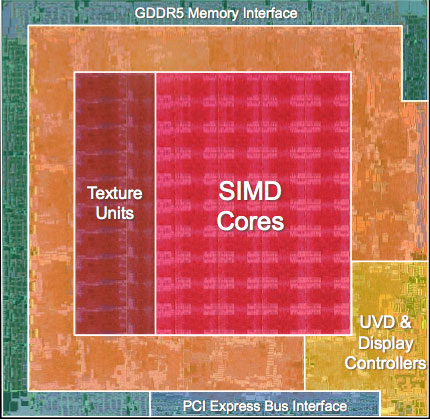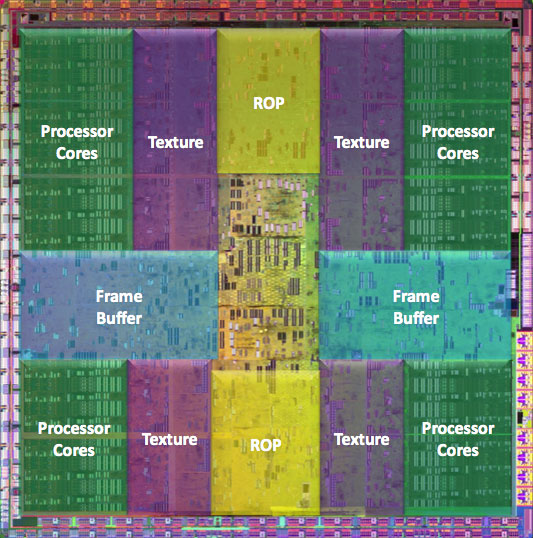The Radeon HD 4850 & 4870: AMD Wins at $199 and $299
by Anand Lal Shimpi & Derek Wilson on June 25, 2008 12:00 AM EST- Posted in
- GPUs
Wrapping Up the Architecture and Efficiency Discussion
Engineering is all about tradeoffs and balance. The choice to increase capability in one area may decrease capability in another. The addition of a feature may not be worth the cost of including it. In the worst case, as Intel found with NetBurst, an architecture may inherently flawed and a starting over down an entirely different path might be the best solution.
We are at a point where there are quite a number of similarities between NVIDIA and AMD hardware. They both require maintaining a huge number of threads in flight to hide memory and instruction latency. They both manage threads in large blocks of threads that share context. Caching, coalescing memory reads and writes, and handling resource allocation need to be carefully managed in order to keep the execution units fed. Both GT200 and RV770 execute branches via dynamic predication of direction a thread does not branch (meaning if a thread in a warp or wavefront branches differently from others, all threads in that group must execute both code paths). Both share instruction and constant caches across hardware that is SIMD in nature servicing multiple threads in one context in order to effect hardware that fits the SPMD (single program multiple data) programming model.
But the hearts of GT200 and RV770, the SPA (Steaming Processor Array) and the DPP (Data Parallel Processing) Array, respectively, are quite different. The explicitly scalar one operation per thread at a time approach that NVIDIA has taken is quite different from the 5 wide VLIW approach AMD has packed into their architecture. Both of them are SIMD in nature, but NVIDIA is more like S(operation)MD and AMD is S(VLIW)MD.

AMD's RV770, all built up and pretty
Filling the execution units of each to capacity is a challenge but looks to be more consistent on NVIDIA hardware, while in the cases where AMD hardware is used effectively (like Bioshock) we see that RV770 surpasses GTX 280 in not only performance but power efficiency as well. Area efficiency is completely owned by AMD, which means that their cost for performance delivered is lower than NVIDIA's (in terms of manufacturing -- R&D is a whole other story) since smaller ICs mean cheaper to produce parts.

NVIDIA's GT200, in all its daunting glory
While shader/kernel length isn't as important on GT200 (except that the ratio of FP and especially multiply-add operations to other code needs to be high to extract high levels of performance), longer programs are easier for AMD's compiler to extract ILP from. Both RV770 and GT200 must balance thread issue with resource usage, but RV770 can leverage higher performance in situations where ILP can be extracted from shader/kernel code which could also help in situations where the GT200 would not be able to hide latency well.
We believe based on information found on the CUDA forums and from some of our readers that G80's SPs have about a 22 stage pipeline and that GT200 is also likely deeply piped, and while AMD has told us that their pipeline is significantly shorter than this they wouldn't tell us how long it actually is. Regardless, a shorter pipeline and the ability to execute one wavefront over multiple scheduling cycles means massive amounts of TLP isn't needed just to cover instruction latency. Yes massive amounts of TLP are needed to cover memory latency, but shader programs with lots of internal compute can also help to do this on RV770.
All of this adds up to the fact that, despite the advent of DX10 and the fact that both of these architectures are very good at executing large numbers of independent threads very quickly, getting the most out of GT200 and RV770 requires vastly different approaches in some cases. Long shaders can benefit RV770 due to increased ILP that can be extracted, while the increased resource use of long shaders may mean less threads can be issued on GT200 causing lowered performance. Of course going the other direction would have the opposite effect. Caches and resource availability/management are different, meaning that tradeoffs and choices must be made in when and how data is fetched and used. Fixed function resources are different and optimization of the usage of things like texture filters and the impact of the different setup engines can have a large (and differing with architecture) impact on performance.
We still haven't gotten to the point where we can write simple shader code that just does what we want it to do and expect it to perform perfectly everywhere. Right now it seems like typical usage models favor GT200, while relative performance can vary wildly on RV770 depending on how well the code fits the hardware. G80 (and thus NVIDIA's architecture) did have a lead in the industry for months before R600 hit the scene, and it wasn't until RV670 that AMD had a real competitor in the market place. This could be part of the reason we are seeing fewer titles benefiting from the massive amount of compute available on AMD hardware. But with this launch, AMD has solidified their place in the market (as we will see the 4800 series offers a lot of value), and it will be very interesting to see what happens going forward.










215 Comments
View All Comments
shadowteam - Wednesday, June 25, 2008 - link
Did you know these chips can do up to 125C? 90C is so common for ATI cards, I haven't had one since 2005 that didn't blow me hair dry. Your NV card was just a bad chip I suppose. Why do you think NV or ATI would spend a billion dollars in research work, then let its product burn away due to some crappy cooling? They won't give you more cooling than you actually need. It's the same very cards that go to places like Abu-Dhabi, where room temps. easily hit 50C+.soloman02 - Wednesday, June 25, 2008 - link
Sorry, but no human would survive a temp of 50C.http://en.wikipedia.org/wiki/Thermoregulation#Hot">http://en.wikipedia.org/wiki/Thermoregulation#Hot
In fact the highest temp a human has survived was recorded by the Guinness book of world records as: 46.5C (115.7F). Keep in mind that was the internal temp of the guy. The temp on that day was 32.2C (90F).
http://www.powells.com/biblio?show=0553587129&...">http://www.powells.com/biblio?show=0553587129&...
http://www.time.com/time/magazine/article/0,9171,9...">http://www.time.com/time/magazine/article/0,9171,9...
If it is 50C in those rooms, the people inside are dead or dying.
The cards are probably fine. All it takes is to search google to back up your figures (or to disprove them like I just did).
shadowteam - Wednesday, June 25, 2008 - link
You're just a dumb pissed off loser. There's a big difference in internal human temperature to its surroundings. In places like Sahara, temperatures routinely hit 45C, and max out @ 55C. But does that mean people living there just die? No they don't, because they drink a lot of water, which helps their bodies get rid of excess heat so to keep their internals at normal temperature (32C). You didn't have this knowledge to share so you decided to Google it instead, and make fool out of yourself. Here, let me break it down for you,You said: "Keep in mind that was the internal temp of the guy"
Exactly, the guy was sick, and when you're sick, your body temperature rises, in which case 46C is the limit of survival. I suggest you take Bio-chemistry in college to learn more about human body, which is another 4 years before you finish school.
Ilmarin - Wednesday, June 25, 2008 - link
I'm not talking about chips failing altogether... just stability issues, similar to what you experience from over-zealous overclocking. Lots of people have encountered artifacting/crashes with stock-cooled cards over the years. If these are just 'bad chips' that are experiencing stability issues at high temps, then there are a lot of them getting through quality control. Of course NV and ATI do enough to make most people happy... but many of us have good reason to be nervous about temperature. I think they can and should do better. Dual slot exhaust coolers should be mandatory for the enthusiast/performance cards, with full fan control capability. Often it's up to the partners to get that right, and often it doesn't happen for at least a couple of months.shadowteam - Wednesday, June 25, 2008 - link
I think it's more profitable for board partners to just roll out a stock card rather than go through the trouble of investing time/money into performance cooling. What I've seen thus far, and it's quite apparent, that newer companies tend to go exotic cooling to get themselves heard. Once they're in the game, it's back to stock cooling. For example, Palit and ECS came up with nice coolers for its 9600s. Remember Leadtek from past years? They don't even do custom coolers any more. ASUS, Powercolor, Gigabyte, Sapphire etc just find it easier to throw in a 3rd party cooler from ZM, TT TR, and call it a day.DerekWilson - Wednesday, June 25, 2008 - link
you know we actually received an updated bios for a certain vendors 4850 that speeds the fan up a bit and should reduce heat ...i suspect a lot of vendors will start adjusting their fan tables actually ...
shadowteam - Wednesday, June 25, 2008 - link
I think this reply was meant for the guy right above me. I'm all for stock cooling :).ImmortalZ - Wednesday, June 25, 2008 - link
"Quake Wars once again shows the 4870 outperforming the GTX 280, but this time it offers essentially the same performance as the GTX 280 - but at half the price. "You mean the 260 in the first instance?
No text in The Witcher page. I assume this is intentional.
Also, I've heard on the web that the 48xx series has dual-link only on one of it's DVI ports. Is this true?
Oh and another thing - why is the post comment page titled "Untitled Page"? :P
rahat5810 - Wednesday, June 25, 2008 - link
Nice cards and nice article. But I would like to point out that there are some mistakes in the article, nothing fatal though. Like, not mentioning 4870 in the list of cards, writing 280 instead of 260, clicking on the picture to enlarge not working for some of the figures.feelingshorter - Wednesday, June 25, 2008 - link
AMD almost has a perfect card but the fact that the 4870 idles at 46.1 more watts than the 260 means the card will heat up people's room. At load, the difference of 16.1 watts more for the 4870 is forgivable.If its possible to overclock a card using software (without going into BIOS screen), then why isn't it possible to underclock a card also using software when the card's full potential isn't being used? I'd really be interested in knowing the answer, or maybe someone just hasn't asked the question?
I hardly care about Crysis, its more a matter of will it run Starcraft II with 600 units on the map without overheating. Why doesn't anandtech also test how hot the 4870 runs? Although the 4850 numbers aren't pretty at all, the 4870 is a dual slot cooler and might give better numbers right? I only want to know because, like a lot of readers, i have doubts as to whether a card like the 4850 can run super hot and not die within 1+ years of hardcore gaming.